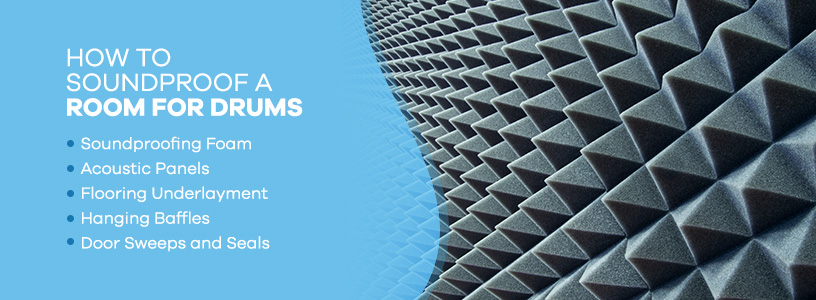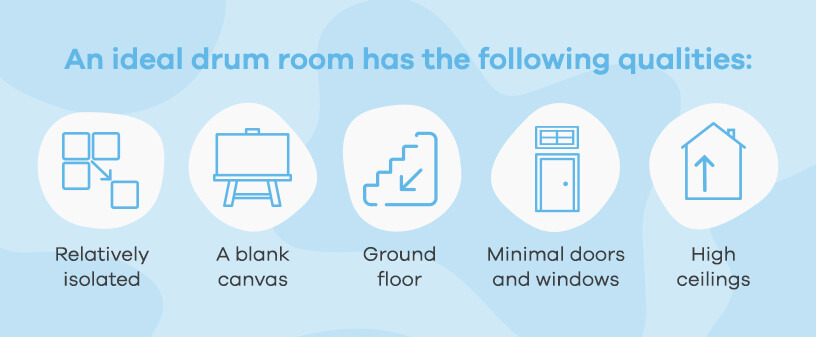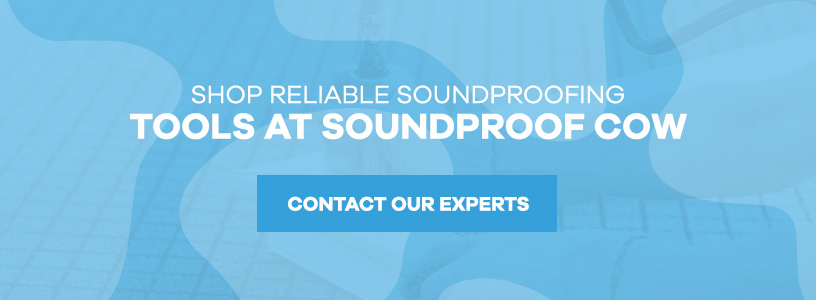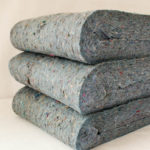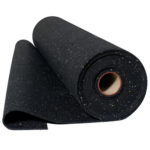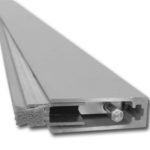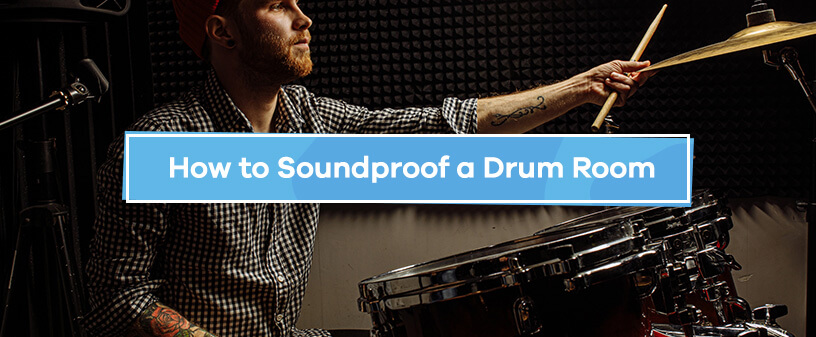
As you play your drums, the room around you fills with energy — and not just the kind that makes people want to get up and dance. Noise travels around your drum room in energy-charged waves that bounce off your floors, walls, ceilings, and doors until they run out of energy. Excess soundwaves can muddle your playing and disturb your neighbors.
Continue reading to learn more about the drum room soundproofing methods you can use to keep your music sounding clean and ensure harmonious relationships with your neighbors.
Why Should You Soundproof Your Drum Room?
By soundproofing your drum room, you’ll benefit in the following ways.
- Avoid noise complaints: Drums are a loud instrument. Soundproofing controls the amount of noise that leaves your drum room, limiting the number of noise complaints from neighbors.
- Practice at any time of the day: If you’re a drummer, you’re likely familiar with planning your sessions around the perfect time that won’t disrupt the people living around you. A soundproof drum booth allows you to play whenever the inspiration strikes you.
- Improve sound quality: When you play the drums, you create many soundwaves that bounce around the smooth surfaces in your drum room, like the floors, ceilings, walls and doors. The excess soundwaves create a muddied sound that detracts from your tight beats. Soundproofing tools capture these soundwaves, clearing the space for improved sound quality.
How to Create a Soundproof Drum Room
The people around you can hear music from your drum room because of airborne noise. Typical residential homes with average walls and ceilings don’t have enough built-in soundproofing materials, so you’ll need to install these for better results. Create a drum sound barrier by starting with your ceilings and moving down to your floors.
1. Ceilings
For your ceiling, install the isoTRAX® Soundproofing System. This kit includes sound isolation rails that separate the drywall from the studs. For even better performance, seal gaps and edges. You can also add hanging baffles to your ceiling as a final touch.
2. Walls
Adding a thicker-than-usual layer of drywall will benefit your walls. Be sure to decouple the drywall from the other layers for maximum results. Add cotton insulation that fits into your walls to control sound transfer. Quiet Batt® Soundproofing Insulation is an excellent choice. A second layer of drywall will prevent sound from escaping your room. You can add acoustic panels to lessen noise and increase your drum room’s decorative appeal. Always check for any gaps where sound vibrations may escape.
3. Doors
Doors are an area where sound tends to get out the most, as these are less soundproof than your walls and ceilings. If your door is hollow, replace it with a solid-core door. Second, address the gaps around your door. Door seals and sweeps ensure sound doesn’t escape from any cracks or openings. These kits seal to the sides, top and bottom of your door. Once you shut the door, the bottom seal applies pressure to the floor, making it soundproof.
4. Floors
Soundproofing your floor is as essential as the rest of your drum room, especially if you’re higher than the first floor. You’ll need to remove your flooring and install a soundproof underlayment. Add heavy carpet, a thick rug, and a riser under your drum kit for extra reinforcement.
Best Products to Use for Drum Room Soundproofing
Here are five drum sound-dampening products drummers can use in their studio.
1. Soundproofing Foam
Usually, soundproofing foam is the first thing people picture when imagining soundproofing methods. They reduce reverberations by preventing sound from bouncing off smooth surfaces and back into the room.
For music studios, consider these products.
- Pyramid acoustic foam: The pyramid acoustic foam consists of polyurethane foam containing pores that trap soundwaves and absorb their energy. As its name may suggest, the textured surface has rows of pyramid-shaped foam, creating more surface area for optimal absorption.
- Udderly Quiet® anechoic acoustic foam: Soundproof Cow’s Udderly Quiet® anechoic acoustic foam works similarly to the pyramid acoustic foam, except it contains ridges rather than pyramids. This soundproofing foam absorbs high, mid-range and low-frequency sounds.
- Bass wedge acoustic foam: Perhaps the most common soundproofing foam, the bass wedge acoustic foam looks like elongated pyramids made of studio-grade foam. If you’re on a budget, these soundproofing tools are highly cost-effective and provide noticeable results.
Apply the drum soundproofing foam using an acoustic adhesive, like the PL® Premium Construction Adhesive.
2. Acoustic Panels
Drum soundproofing acoustic panels usually consist of compressed mineral wool or foam. Wool and foam hold tiny fibers that trap soundwaves and absorb their energy. it won’t absorb all sound — but it will minimize echoes, muffling, and reverberation. That way, nothing distracts from your rhythms.
At Soundproof Cow, we offer three types of acoustic panels for drum rooms.
- Art acoustic panels: If you’re looking for an understated soundproofing solution, art acoustic panels are a good solution. You can choose an image or colorful design that complements your drum room’s aesthetic, blending the worlds of artwork and soundproofing.
- Fabric-wrapped acoustic panels: Like art acoustic panels, fabric-wrapped acoustic panels are wrapped in decorative fabric. Pick various sizes, colors, and configurations to match your drum room’s furniture and decor.
- Perforated acoustic panels: Consider perforated acoustic panels for a more natural appearance. These wood panels have perforations that trap excess soundwaves. Find perforated acoustic panels in many finishes, styles, and sizes.
3. Flooring Underlayment
Soundwaves travel in all directions. Flooring is often an afterthought. Strengthen your floor’s soundproofing abilities with a quality product like the Impact Barrier QT flooring underlayment, which looks like a rubber cork. It consists of 92% recycled tire rubber, which absorbs impact and blocks airborne noises.
Place the Impact Barrier QT flooring underlayment under tile, carpet, laminate, hardwood, and other floorings. It’s thin, adding less than half an inch of floor height. Once you apply it, you won’t see any exposed soundproofing material, but you’ll notice a difference in how sound travels from your drum room.
4. Hanging Baffles
Soundwaves travel in every unobstructed direction. If you have tall ceilings, that can be problematic for your sound quality. Control this upward travel using a hanging baffle, like the Udderly Quiet® Acoustic Baffle.
Hanging baffles suspend from your ceiling using a light-duty chain. The chain attaches to the sound-absorbing panels. You can find hanging baffles in fabric-wrapped options or made entirely of cotton, such as the Echo Absorber™ hanging baffle. Both are excellent options when acoustically treating your drum room’s ceilings.
5. Door Sweeps and Seals
Doors are responsible for sound loss in most rooms, along with any other areas where noises can escape from your residential or commercial space. Take a moment to look at your door — do you see the empty spaces around the frame? If you knock on the center of the door, you may also hear a hollow sound. Both qualities allow soundwaves to magnify and escape out of your drum room.
Manage these soundwaves using door sweeps and seals. Sweeps cover the larger space at the bottom of your door, while seals take care of the smaller gap around the door frame.
Both options consist of aluminum and silicone. Aluminum gives door sweeps and seals durability, while the silicone forms a tight seal to prevent soundwaves from escaping. Application is quick and easy, requiring a few simple tools and easy to follow instructions.
What’s the Best Space for a Drum Room?
The best spaces for a drum room are sheds, garages or basements. A drum room creates a lot of noise, so it’s best to follow a checklist when selecting the best space to practice in. An ideal drum room has the following qualities.
- Relatively isolated: A room away from living areas and bedrooms.
- A blank canvas: As you’ll need to modify the space significantly, an empty room you can transform is best.
- Ground floor: The ground floor ensures you won’t disturb anybody below you.
- Minimal doors and windows: The fewer doors and windows, the less chances of sound escaping.
- High ceilings: A high ceiling ensures soundwaves have a longer travel time, losing some noise impact.
Purchase Soundproof Materials at Soundproof Cow
Soundproof Cow can help you soundproof your drum room. We’ve been actively creating innovative soundproofing methods for over two decades, providing our clients with DIY solutions.
The most significant sound-polluting areas of your drum room you want to address are your floors, ceilings, walls and doors. Soundproof Cow offers solutions for all these, and you don’t have to spend tens of thousands of dollars for professional soundproofing solutions.
Learn more about what Soundproof Cow can do for you by browsing our products online. To talk to a representative about how we can make your music sound cleaner and crisper, contact us online via our contact form or call us at 866-949-9269.




